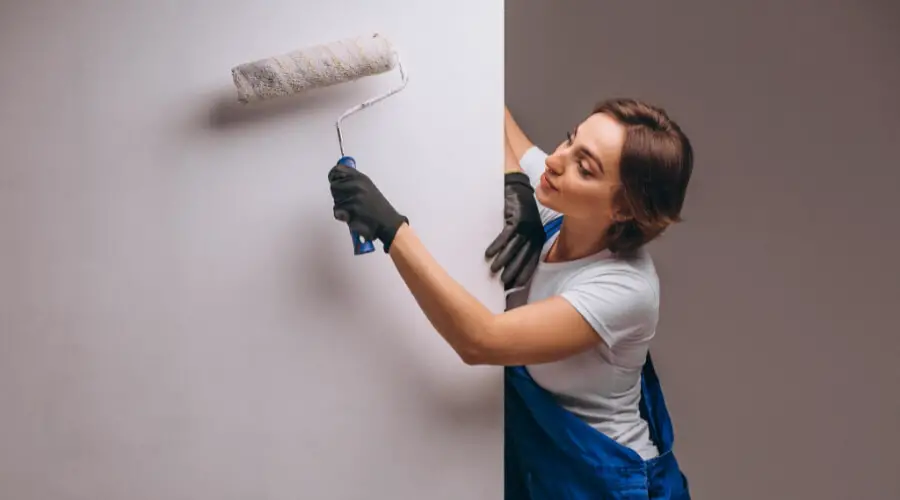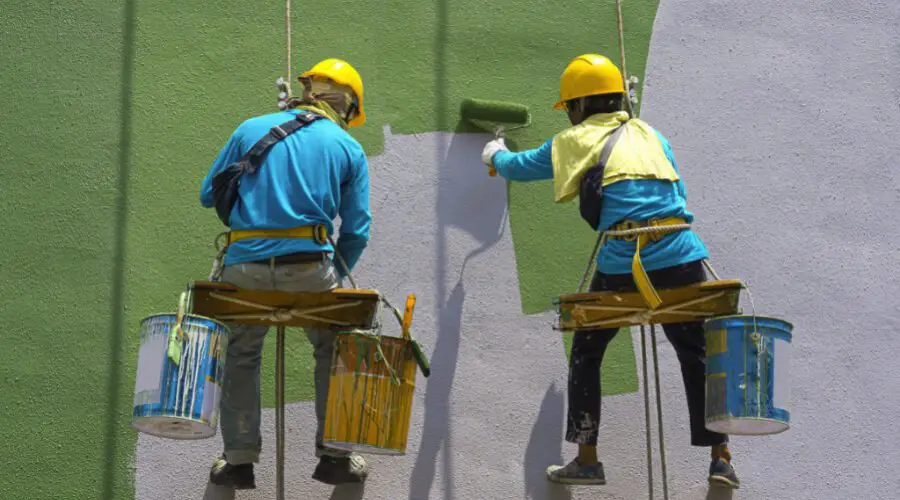Last Updated on July 24, 2023 By Emma W. Thomas
Ceiling paint is formulated to prevent drips and splatters while providing better coverage for overhead surfaces. Wall paint, on the other hand, is designed for vertical application, ensuring smooth finishes and enhanced durability. Both serve distinct purposes, optimizing the overall appearance and longevity of your interior surfaces.
Comparison of Ceiling Paint And Wall Paint
| Parameters | Ceiling Paint | Wall Paint |
|---|---|---|
| Formulation | Ceiling paint is formulated to hide minor imperfections and marks, often offering a flat and non-reflective finish. | Wall paint is designed to be resistant to washing, touching, and can contain greater visual textures such as satin, eggshell, gloss, or semi-gloss finishes. |
| Durability | Ceiling paint is generally not exposed to as much damage or touch as wall paint, hence durability is lower compared to wall paint. | Wall paint is specifically designed to withstand frequent touching and cleaning, making it more long-lasting and durable. |
| Colour Options | Usually, ceiling paint comes in white or off-white shades to reflect natural light and make the room seem larger. | Wall paint offers an extensive range of color choices, it can match with any room’s decor, furnishings, or vibe. |
| Application | Ceiling paint is frequently thicker and doesn’t splatter much, easing the painting process. | Wall paint can be applied easily with brushes or rollers; however, precautions for drips or splatters are often needed. |
| Price | Ceiling paint tends to be pricier due to its unique formulation and reduced demand compared to wall paint. | Wall paints are generally less expensive due to their widespread use and high demand. |
Definition Of Ceiling Paint And A Wall Paint

Paint is a liquid that is easily applied after a transformation into a thick consistency. If you are wondering what ceiling and wall paint entails, this section aims to explain them further. However, before we get to the various distinguishing aspects, be sure that they both have unique attributes. They also have different characteristics that may influence the final look of your home.
What Is Ceiling Paint?

Ceiling paint is flat paint with a nice blending and sheen finish. The aspect of a sheen finish makes it more suitable for cleaner surfaces compared to matte finishes. Moreover, it makes painting at a vertical angle much easier due to the presence of additives. As the name suggests, it is typically designed for use on the ceiling. It covers all the imperfections, and you’ll be sure of no splatters, with just a single coating.
Types Of Ceiling Paint:
There are various types of ceiling paint that give you multiple options when shopping around for one. However, ceiling paint is only available in limited colors, restricting you from playing around with color. The typical standard for ceiling paint is white and shades of white. Nonetheless, you can still mix the custom colors suppose you are looking forth to having colored tops. It is essential to envision the final outlook of the roof before proceeding to paint the darker shades. The light colors significantly impact the rooms and highlights, similar to the tops’ white paint color.
Various ceiling paints differ in their price range and durability. Here’s an example;
Prestige Paint Interior Paint And Primer In One Ceiling Paint:
It is a fantastic latex paint for the ceilings. It is effortless to clean up since it goes on as smoothly as latex paint. I’m sure by now you are wondering whether it is available in multiple colors. Well, this is an excellent ceiling paint for a perfect finish that also gives you a wide range of color options to choose from. You can go ahead and make this your option as it is versatile and durable.
What Is A Wall Paint?

Wall paint is not to be confused with wall painting. The latter refers to a work of art displayed on a wall and is also referred to as a mural. Wall paint is a thin type of paint used on walls. To have an excellent finish on plastered walls, you will need more than one layer of paint.
Types Of Wall Paints:
You can find several types of wall paints depending on the room that you are planning to paint. For instance, you should use wall paint resistant to mildew or mold for your bathrooms due to exposure to water. You will also need to be careful when choosing wall paint for your kids’ bedroom. You’ll need something resistant to scrubbing and easy to clean frequently. Additionally, the same also applies to the kitchen wall.
1. Water-Based Wall Paint:
It is a type of paint that requires you to clean the walls first before painting. Assuming that the previous color you had on the walls was oil-based, you can use an uneven surface with the sandpaper to smoothen it to the desired texture. After that, it’ll help in sticking to the surface of the wall.
2. Oil-Based Wall Paint:
Oil-based paint is recommended for its rich finish and high durability. However, it can be overwhelming as it emits powerful fumes. It can hardly be washed with water, though it can be applied on almost all surfaces. Be cautious when using it and use turpentine to clean the materials with unwanted paint or brushes.
3. Crown Solo One Coat Satin:
You will need only one layer for a professional, fully opaque finish with this kind of paint unless you’re painting over a dark color. It is not drippy or challenging to apply due to its thick consistency that ensures excellent coverage. It has a 6-12 hours drying time; then, you’ll be on the go after the first coat is dry.
Differences Between Ceiling Paint And Wall Paint:
Suppose you are preparing for some interior painting; this is vital information to influence your final choice of paint. Whether you go for ceiling or wall paint, the following are some of the differences to consider.
| Aspect: | Ceiling Paint: | Wall Paint: |
| Color | You can easily apply it from its formation either as pink or pale blue and then it dries out as white. This is depending on how some brands make them. It simply enables you to apply uniformly because you can spot the missed areas easily. Due to its limitation of available colors, you’ll most likely color your paint manually in case you want something less familiar. | It can be used to create various exciting patterns and designs from numerous different hues, a variety of colors, and finishes. This makes them very flexible. |
| Composition: | The paint hides all the imperfections when covering all the edges. It has its way of covering minor irregularities as it is flat and inaccessible to the light’s reflection. It can eliminate drippiness as it is equally more viscid. | You can easily clean wall paint with soap and water from its durable design. Moreover, it’s not easily damaged by scrubbing when cleaning. You can find it in various finishes, and suppose you want to make the room feel more spacious, glossy wall paint is the choice for you. |
| Viscosity | It has higher viscosity to avoid splattering and splashing. It is a quick-drying paint compared to wall paints. | It is thinner and simply prone to splash and splatters. |
| Durability | Doesn’t peel or crack as it offers strong adhesion to the various texture of surfaces. | Oil-based wall paints are more durable than water-based paints. It’s a perfect choice for trim and molding because the resin makes it hard when dry. |
Factors Affecting The Choice Of Paint
Have you ever thought about the best wall and ceiling paint for your living space? This section aims to unveil the essential factors to keep in mind before making your final decision. The color choice only completes half of the planning process before handling the paint’s primary task. Below are some of the factors to consider when choosing a color:
Coverage:
Good paint should have the properties of getting perfect coat coverage with various colors. It has to get the job done quickly and cover dark colors and flaws easily.
1. The Factor Of Smell:
It would help if you were cautious about the chemical components present in paint before getting it. It should be free of harmful chemicals regardless of the price. I mean, why spend too much or less on something that will create a health issue that would have been avoided earlier? Keenly, give this a thought and know your priorities.
2. Washability:
Of course, this is very important because it has to do with frequent spots like hallways, kitchens, trim, and porches. Don’t forget that washability is also influenced by the choice of finish you go for. The shinier it is, the easier it gets when cleaning.
3. Colour Richness:
This is important, especially if you’re looking for a long-term kind of paint. Some are designed to hold more profound and richer colors better, making them remain vibrant for years. Now, who doesn’t want a long-lasting beautiful house interior?
Conclusion
Generally, the type of paint you go for depends on the location you intend to paint in the house. You can start with painting a small quantity, like a patch of wall in direct sunlight, suppose you’re painting during the dry season. This will significantly help, considering that it might be a DIY for the first time. I hope all the information has been helpful, and you’re now ready to shop for the right paint for your space. Have fun!
References:
https://www.homedit.com/difference-between-wall-paint-and-ceiling-paint/
https://www.livingletterhome.com/ceiling-paint-vs-wall-paint/
Emma is a graduate of Domestic Science or Family and Consumer Sciences (Home Economics) from the University of Wisconsin. She has 7 years of experience Working with the strategic section of BestBuy and now writing full-time for Homeeon.
From Managing the Home, Interiors, Cleaning, and Exteriors to Gardening and everything about Making A Home Liveable – is her passion and this Homeeon is the result of this.
Emma loves decorating her home with the best stuff found online. She cares about quality over anything and writes reviews about them here in Homeeon. Get in touch with her over Pinterest.
Keep reading her blogs.

